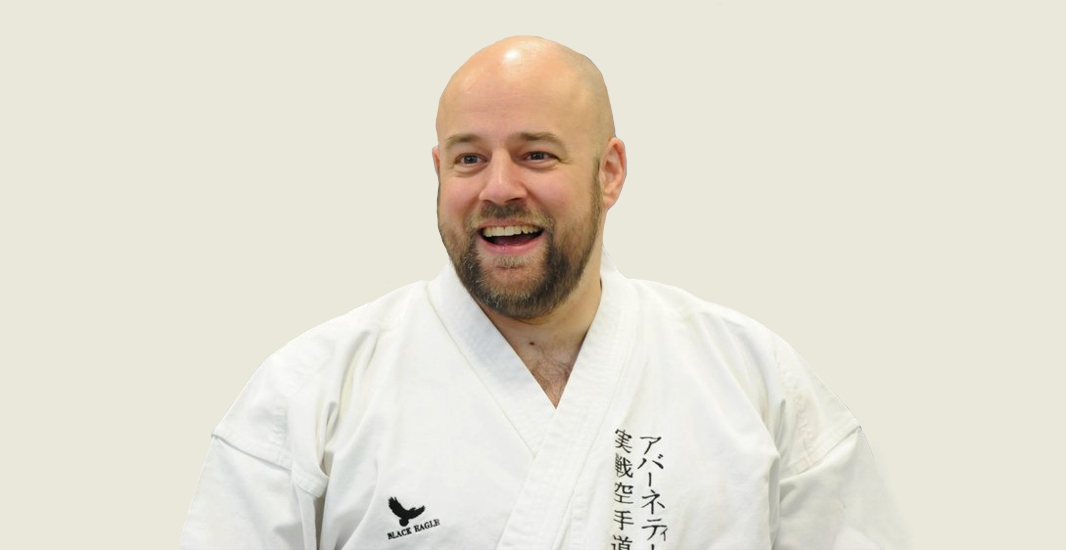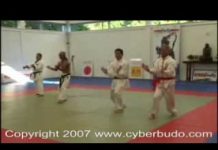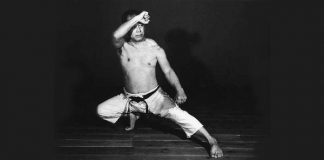It is believed that the native wrestling art of Tegumi, along with the Kempo systems brought to Okinawa by the Chinese, were forerunners of the art that eventually became known as karate.
To adequately defend yourself in a real fight you will need a knowledge of all the various ranges of combat. In a sporting contest there is no need for skills at every range, e.g. a boxer does not need to know how to kick in order to win his bouts, nor will a judoka need a knowledge of punching. However, in a real fight the opponent will not ‘play by the rules’, and if you should find yourself in an unfavorable position there will be no referee to interject and to restart the bout at a range where the combatants know what they are doing! As Geoff Thompson once said, “You can be a 10th Dan on your feet, and a white-belt on your back.”
Karate is most commonly thought of as a kicking and punching system. The scientific principles involved in karate’s striking methods make them very powerful. But what are we to do if our opponent gets inside punching range and we begin to grapple, or worse still, end up fighting on the floor? Karate – as it is commonly practiced – is at its best when applied at middle to long range. The unfortunate but true fact is that most real fights begin close up and almost always include some form of grappling. So why doesn’t modern karate include grappling in its curriculum? It stands to reason that the older versions of the martial arts would cover every range, because to omit any range could very well lead to defeat in combat. So if real self-defence skills are our aim perhaps we should look at the older versions of karate? Within the katas are recorded the original fighting methods of karate. The katas record the original karate system and hence the katas contain techniques and concepts for use at every range, including grappling.
The grappling and seizing aspects of karate are rarely practiced today, but it is vital to understand that grappling was once as much a part of karate as the striking techniques most commonly associated with the art today. Shigeru Egami, in his book The Heart of Karate-do wrote, “There are also throwing techniques in karate… Throwing techniques were practiced in my day, and I recommend that you reconsider them.” Gichin Funakoshi also makes reference to grappling techniques in “Karate-Do Kyohan”. Funakoshi wrote, “…in Karate, hitting, thrusting, and kicking are not the only methods, throwing techniques and pressure against joints are included.” All of karate’s grappling techniques are recorded within the katas, and it is within the katas we need to look if we wish to resurrect this vitally important part of the art.
Tegumi (grappling hands) was the term used to describe the grappling aspect of old style karate. “Tegumi” is also used to describe an indigenous style of wrestling practiced in Okinawa. It is believed that the native wrestling art of Tegumi, along with the Kempo systems brought to Okinawa by the Chinese, were forerunners of the art that eventually became known as karate. Some say that this is reflected in the name chosen for the art. “Karate” (which could also be pronounced as “to-de”) was made up of two characters, the first meaning “China”, to represent the Chinese Kempo influence, and “Te” meaning “hand”, to represent the Tegumi (grappling) influence. As an aside, a differing initial character is used today for “Kara” which means “Empty” – different meaning but pronounced the same; like “which” & “witch” – but originally the character for “China” was used.
Before 1900, karate placed just as much emphasis on the Tegumi elements of the art as it did upon the striking. Karate training would include throws, joint-locks, chokes, strangles, grips, counters etc. In fact, in karate’s early days many practitioners would test their skills in bouts of Kakedameshi (see ‘Tales of Okinawa’s Great Masters’ by Shoshin Nagamine – Translated by Patrick McCarthy). The combatants would interlock their arms and the aim was to knock your opponent to the floor using both Tegumi and striking techniques. These bouts would include a wide array of karate techniques (grappling & striking) and were very different indeed from the striking only sparring of today. In the book, ‘Ryukyu Karate Kempo’ Choki Motobu wrote, “Kumite is an actual fight using many basic styles of kata to grapple with the opponent.” It is apparent that the karate practitioners of the past would utilize grappling techniques from the kata in their training and sparring.
At around 1905 – when karate underwent many changes such that it would be suitable for the physical education for Okinawa’s school children – the regular practice of the more dangerous techniques was discouraged. This rationalization of karate training meant that many aspects of Tegumi were abandoned. It is mainly because of this ‘sanitizing’ of karate that grappling is no longer a common sight in the majority of today’s karate dojos. However, if we wish to practice karate as a complete system of fighting, we should endeavor to include Tegumi in our practice. The wonderful thing is that the katas provide a living record of these methods! If we study the katas in sufficient depth, all aspects of the original fighting art of karate are there for the taking (including Tegumi). Within the katas there are a great deal of grappling techniques in addition to the commonly taught striking methods, with the majority of kata techniques showing the integrated use of both methods. If fact, Toshihisa Sofue 7th Dan has stated that “Eighty percent of karate kata is throwing and locking.” And yet you rarely see throws and locks in today’s dojos!
There are various sub-divisions of Grappling / Tegumi; Tuidi (Grabbing), Nage-Waza (Throws & Takedowns), Kansetsu-Waza (Joint-Locks), Shime-waza (Chokes & Strangles), Ne-Waza (Ground-Fighting), etc. All of which can be found within the katas. If we study the katas to a sufficient depth, we can begin to employ these highly potent methods in our everyday training such that we will not be at a total loss if the fight goes to close-range (as it nearly always does!).
Many Tegumi techniques are fairly brutal. A simple and very effective grappling method can be found within Seishan / Hangetsu kata. You’ll recognise the technique demonstrated in the picture that accompanies this article as the application of the inward pull prior to the first 180-degree turn. The index fingers are inserted into the opponent’s mouth and pulled apart (commonly called “fish-hooking”). It is important to keep sufficient tension in the opponent’s cheeks such that they are unable to turn the head and bite the fingers. If I were to pull strongly to the sides – as per the Shotokan version of the katas – I would cause severe damage to my opponent’s face. Obviously the use of this technique would only be justified in very extreme circumstances.
It is important to understand that the katas are first and foremost a record of combative concepts and principles. These concepts and principles are infinitely more important than the techniques used to demonstrate them. We should study the grappling methods of the kata to such a depth that we are able to adapt the techniques – in line with the principles upon which they rest – for use in whatever circumstances we may find ourselves. Master Chotoku Kyan (1870-1945) – one of his favourite katas being Seishan – adapted the Fish-Hooking technique shown in the picture to good effect during a challenge bout with a 6th Dan Judoka called Shinzou Ishida. Master Kyan was visiting mainland Japan in order to give a karate demonstration. Ishida, being a skilled grappler, had asked Kyan for a match because he wished to ascertain the value of karate. When Ishida reached out to seize his opponent, Kyan slipped to the side and thrust his thumb into Ishida’s mouth. Kyan closed his fingers, stamped on Ishida’s foot and then pulled the off balance judoka to the floor by his cheek. Kyan then delivered a hammer fist to Ishida’s jaw, stopping it just short of the target. Ishida was impressed by Master Kyan’s skill and went onto receive daily instruction from him until he returned to Okinawa. This is a fine example of how the Tegumi principles recorded within the katas can be used to good effect.
To be an effective fighter it is imperative that you have a knowledge of all ranges of fighting. Hence, it is vital that Tegumi forms part of our practice, just as it did for the masters of the past who formulated karate. Thankfully, those same masters recorded their grappling methods in the katas they developed. The key thing is to ensure that you study your katas to a sufficient depth. Thanks for taking the time to read this article. I hope you found it interesting.







